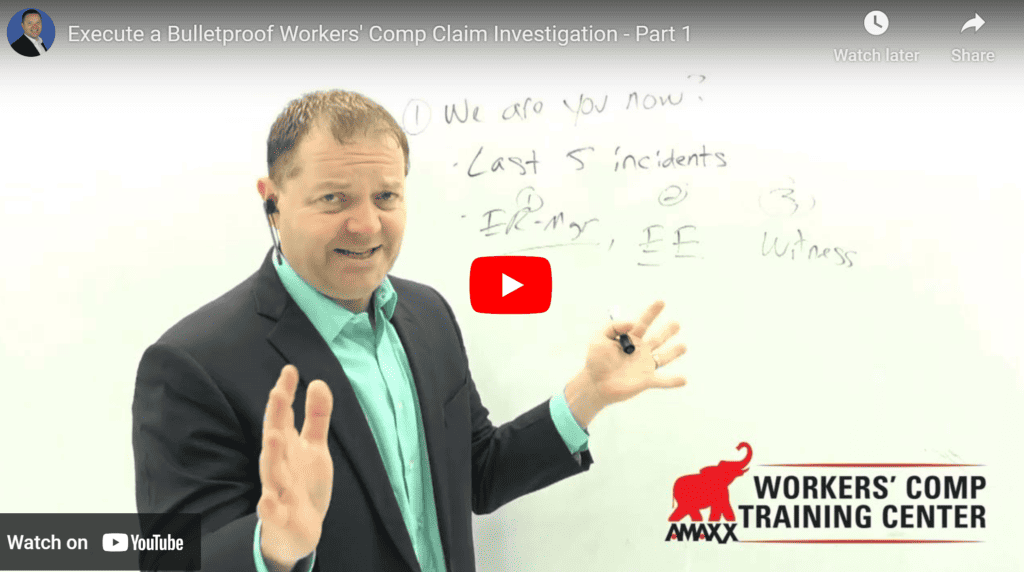No one likes the cost of workers’ compensation litigation.
Win Litigation at the End, or at the Beginning
Hello, my name is Michael Stack. I’m CEO of Amaxx. I’m going to do a little three-part series here on how to execute a Bulletproof Workers’ Comp claim investigation. As my friend Stuart Colburn says, attorney, defense attorney, he says, you could either win the case at the end in the courtroom by presenting and presenting all the evidence and doing a great job with that at the end in court. Or you can win it at the beginning, or you can win it at the beginning. It’s much less costly, it’s much less frustrating. It’s much less irritating and aggravating to win the case consistently at the beginning by consistently documenting in a thorough degree your workers’ compensation incidents, things that happen. So as I’m going to walk you through this little series here, I’m going to go through some points and some application and implementation tactics that can help you do that consistently, can help you do that consistently well.
Step 1: What Are You Currently Doing?
And in this first video, I want to walk you through step number one, step number one in this process. And here’s the thing with step number one is where are you now? How are you currently doing? How are you currently doing? The first step in understanding how to improve your current system is to just take a look at what you’re currently doing. Now, what are you doing? Now, this is not your first road. You’ve had workers’ compensation claims in the past. How are you doing now? And here’s what I want you to do. I want you to take a look at your last five. So your last five, your last five incidents.
How’d you do, how’d you do, how’d you do on those? And here’s some points that I want you to take a look at. Do you have a separate report of injury for the employer or the manager? So the manager or employer report. Do you have an incident report for that? Do you have a separate incident report for the employee? So do you have an employee report and do you have an employer or a manager report? And then number three, do you have a witness report? Do you have a separate witness report? Do you have separate reports for each of these? And if there were multiple witnesses, do you have multiple witness reports? So there were three witnesses or five witnesses, however many witnesses were on the case. 1, 2, 3, 4, 5, however many there were. Do you have witness reports for each one of those? Do you have an employee version of that?
How Well Are Forms Completed?
And do you have an employer or a manager or supervisor version of what happened at the case? That’s question one. Do those exist at all? Question number two is how well were they completed? How well were they completed? Were they thoroughly completed? Is it easy to read the information? Is it well documented? Is it accurate? The information that’s on there, how well were they completed? And I think that you’ll agree with me a lot of times, particularly with companies that are using paper forms, they’re just not done very well. You either don’t have this or you have, you know what? Yeah, this happened and okay, great, and blah, blah, blah, and okay, I’m done. That’s all the information I want to give here. And there’s tons of blanks on those forms. So how well were they completed? And then number three, actually even not only how well were they completed, it’s how well is the form designed.
So do you have a form that’s just check boxes or is it open answers? So yeah, I did this and this and this, and this happened, and blah, blah, and there was wetness on the floor and the ladder came and Tom asked me to do this, and blah, blah, blah, whatever it was, how well were they completed? And what is that form design where they’ve even set it up for success so that you can get more open answer information if it’s just check boxes, that’s not even given a lot of good information for it to the adjuster to do their job. Next question in this, take a look at your state first report of injuries and your OSHA forms, your state first report of injury and your OSHA forms.
Look at the Last 5 Reports of Injury
Take a look at your last five. How well did you do on those? You got to do an OSHA 301 that’s required, and you got to do a state first report of injury. Attorneys will often say, how well this is completed will determine the outcome of the claim, how well these reports of injury, particularly the state first report of injury, how well that’s completed. Again, is it thoroughly completed? Is it accurate? Was it done efficiently or is it a hot mess? Take a look at how you’re doing now. Step one, in being able to execute a consistently well done accidental investigation starts here, starts by understanding where you are currently at in regards to your employer report of injury, your employee, your witness reports, your state first report of injuries, and your oaths reports. These should be done consistently well every time. How are you doing now? How are you doing now? That’s step number one in our first video here of how to implement this and how to get these results consistently done well, right here. Take a look at those reports. When you understand this, that sets you up for success to improve.
Again, my name is Michael Stack. I’m the CEO of amex. Remember, your work today in workers’ compensation can have a dramatic impact on your company’s bottom line, but it will have a dramatic impact on someone’s life. So be great!
Michael Stack, CEO of Amaxx LLC, is an expert in workers’ compensation cost containment systems and provides education, training, and consulting to help employers reduce their workers’ compensation costs by 20% to 50%. He is co-author of the #1 selling comprehensive training guide “Your Ultimate Guide to Mastering Workers’ Comp Costs: Reduce Costs 20% to 50%.” Stack is the creator of Injury Management Results (IMR) software and founder of Amaxx Workers’ Comp Training Center. WC Mastery Training teaching injury management best practices such as return to work, communication, claims best practices, medical management, and working with vendors. IMR software simplifies the implementation of these best practices for employers and ties results to a Critical Metrics Dashboard.
Contact: mstack@reduceyourworkerscomp.com.
Workers’ Comp Roundup Blog: http://blog.reduceyourworkerscomp.com/
©2024 Amaxx LLC. All rights reserved under International Copyright Law.
Do not use this information without independent verification. All state laws vary. You should consult with your insurance broker, attorney, or qualified professional.




